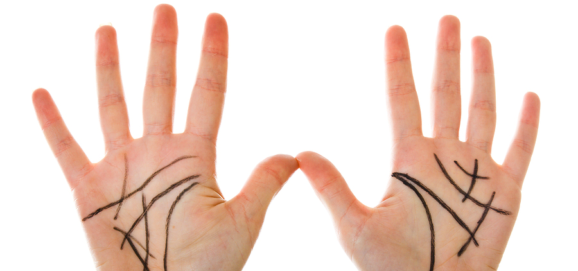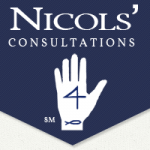Are you Operating from the Right Side or Left Side of Your Brain, or Are You Balanced? Check your Palms

Before I became a full-time psychic and palmist, I trained as a medical speech-language pathologist, and spent several years working in hospital and psychiatric settings. In addition to learning speech therapy techniques, I studied neuropsychology, which includes the functions of the brain, all of which helped me understand what my stroke and head-injury patients were experiencing.
For years I had heard people talk about being “left-brained” or “right-brained,” and I learned that indeed there are many different functions and abilities which are influenced or controlled by one side or the other of the brain. I was also taught that our brains are adaptive and there can be a cross-over of signals from one side to the other, especially if a person is left-handed or ambidextrous. Simplified, right brain functions tend to include visuospatial, three-dimensional, emotional, creative and intuitive areas, while left brain functions tend to include logical, rational, critical/analytical assessments and expressions.
In dealing with these concepts and using the metaphor of crossing the street, I see the left-brain operating system as tending to look down at our feet to make sure we don’t step into the gutter, while the right-brain operating system tends to look down the street to see if the bus is coming to run us over. Of course, ideally, the brain needs to alternate between both operating systems, to see both the gutter and the oncoming bus, and use both sides like joining two horses to pull the wagon. Hence, finding a balance. Over the years I have seen that if we are too much in our right brain and we experience fear, we can become depressive and feel discouraged, hopeless or helpless. If we are too much in our left brain and we experience fear, we can slip into denial of the truth about ourselves or others.
Generally, I have found that people who have predominantly more right-brain operating systems appear to be extremely sensitive and feel vulnerable a lot of the time. They are often hyperaware of their potential to slide into depressiveness. But, I have also found and believe that people tending to operate mainly out of the left brain are in fact even more sensitive than those operating out of the right, seemingly hypersensitive, subconsciously wanting to avoid the pain of negative emotions. That emotional hypersensitivity can create a wall of protection that is difficult for that person to break out of, or people around them to break through.
In my study of palmistry for over 50 years, I feel I have discovered how palmar lines can suggest whether a person operates predominately out of either the right or left hemisphere of the brain, or has a balance of the two. In reading a person’s palms, I tend to focus mainly on the person’s dominant hand, right if they are right-handed, left if they are left-handed. The dominant hand reflects what we have done since birth, where we are now, and where we are going. If a person is ambidextrous, I first go with which hand they use to write with, or else use and interpret a composite of both hands. The non-dominant hand I interpret like a natal horoscope, the potential we arrived with at birth.
After determining hand dominance, I look at the head line (see Figure 1) which starts somewhere between the base of the thumb and the base of the forefinger, and runs across the hand in the direction of the outside or “heel” of the hand. The head line symbolizes a person’s mental process. The other significant line in this case is the heart line, (see Figure 1) which traverses the palm in the opposite direction, from the upper middle part of the heel of the hand, in some way toward the base of the index finger. The heart line reflects the person’s emotional process.
In Figure 2 (left) the head line or lines and the heart line seem to have a flat trajectory across the palm which I call East/West, and the subject tends to operate more out of their left-brain operating system. Please note (see Figure 4): A single line comprising both the head and heart lines, a “single transverse palmar crease,” is an indication that the head and the heart operate as one, a very left-brain orientation. I have seen the hands of many successful or famous people who have this marking, but it suggests that while they are able to totally focus on their worldly pursuits, they may also be continuing to work on opening up their vulnerability and emotions.
Figure 2 (right) reflects more of a right-brain orientation, in which the subject would be more aware of emotional and creative experiences. You can see that the right-brain head and heart lines are somewhat more up and down in their directions, or what I call North/South. Please note (see Figure 3): If the head line heart line follows a path more sharply down in the hand, or droops toward the middle or bottom, there may be tendencies for genetic neurochemical depressiveness in the family.
Please refer back to Figure 1, which shows more of a balanced head line/heart line system, not exactly East/West or North/South, but somewhere in between. This configuration suggests the person could be straddling the two operating systems, which indicates more balance.
Many years ago, after I had left speech pathology and was engaged as a full-time psychic and palmist, one of my grad school professors called me and said he had heard that I was a “psychic.” He related that he was the faculty sponsor of a local “stroke club” comprised of stroke survivors from the surrounding community. A simple definition of a “stroke” is a brain injury or bleed which deprives the brain cells of oxygen, often resulting in the death of brain cells, which can create speech and language, cognition and physical difficulties. The group was meeting regularly and hosted individuals who presented topics of interest to the group. My former professor asked if I would do an introduction to palmistry class for the group, and I agreed. Twelve stroke survivors attended the class, and they had all recovered some or most of their language skills.
During the class I looked at each of the attendees’ dominant hands. I thought the class went well and the group members seemed interested. What I did not reveal to the group was that 9 of the 12 attendees had one right-brain line and one left-brain line in their dominant hands. In other words, they had a head line that arched downward (North/South) and heart line which went straight across (East/West), or a head line that straight across (East/West) and a heart line that arched downward (North/South). This head line/heart line contradiction is something I rarely see in the thousands of clients I have read for over the years.
My observations noted above in the palmistry class were anecdotal and not scientific, and I am not suggesting that if you have these palm line contradictions that you will have a stroke. However, these observations got my attention, and maybe they constitute a tendency or warning for us about conflicts in our consciousnesses. I believe all diseases reflect not only the physical states and realities we may have, but also our consciousness, whether that is causal or just symbolically reflective. I feel if there is a mental/emotional internal conflict combined with other factors, they could ultimately result in a physical manifestation or disease process, such as a stroke.
Also related to the topic of crease lines on the palm suggesting potential medical issues, crease lines in other areas of the body can serve as potential indicators of future disease, as well. For example, on Friday, May 3, 1991, the Austin American Statesman printed an article from the Knight-Ridder Tribune News Service titled “Earlobes, heart attack risk linked.” The article reported on a University of Chicago study which concluded that “people with a diagonal crease in at least one earlobe were significantly more likely to die from heart disease than those without a crease.” Apparently there have also been follow-up studies on the topic, supposedly finding similar indications. Some metaphysicians have suggested that the earlobes are said to be symbolically related to the “heart chakra” or “heart center.” I feel that spiritually a line or crease on the symbolic heart center can indicate a blockage in one’s ability to feel joy, peacefulness, happiness, or patience. This emotional blockage can come from life trauma and fear, and avoidance in dealing with these feelings. I find that clients with significant earlobe creases can also tend to be “workaholics.” In my short time with the stroke club I did not focus on earlobe creases, but it might have been interesting if I knew to look at that.
Generally, I think physics and metaphysics are on a circle, and that they meet each other back at the middle. While I tend to see my intuitive work as an art rather than a science, I sense the boundaries between science and metaphysics blurring more every day. Just like the medical studies on ear lobe creases seem to show a correlation, my impressions about the right-brain/left-brain operating systems indicated by my clients’ palm lines are also suggestive if not predictive, but they do seem to give me a potential path to understanding the mental/emotional approach that my clients may be taking in their lives.
I hope you found this article interesting or thought-provoking.
Thanks,
Joe.
©2024 Joe Nicols All Rights Reserved




